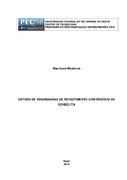Please use this identifier to cite or link to this item:
https://repositorio.ufrn.br/handle/123456789/22457| Title: | Estudo de argamassas de revestimento com resíduo de scheelita |
| Other Titles: | Study of coating mortars with residue scheelite |
| Authors: | Medeiros, Mauriceia |
| Advisor: | Nóbrega, Andreza Kelly Costa |
| Keywords: | Argamassa de revestimento;Resíduo;Scheelita |
| Issue Date: | 19-Dec-2016 |
| Citation: | MEDEIROS, Mauriceia. Estudo de argamassas de revestimento com resíduo de scheelita. 2016. 87f. Dissertação (Mestrado em Engenharia Civil) - Centro de Tecnologia, Universidade Federal do Rio Grande do Norte, Natal, 2016. |
| Portuguese Abstract: | O estado do Rio Grande do Norte possui grande concentração de scheelita, principal fonte de Tungstênio, elemento químico importante na produção em diversos segmentos industriais. Ao extrair esse material do mineral bruto, toneladas de resíduos são geradas e estocadas no meio ambiente. Com isso, este trabalho tem como objetivo analisar o uso do resíduo de scheelita em substituição a areia na formulação de argamassas de revestimento, devido às suas características favoráveis. Foram coletadas amostras do resíduo da scheelita na mina Brejuí, Município de Currais Novos/RN, e após sua caracterização inicial, observou-se a aplicação do resíduo grosso nas argamassas em estudo. Foram preparadas argamassas de traços, 1:1:6 e 1:3, ambos em volume, com percentuais de 0%, 25%, 50%, 75% e 100% de substituição da areia pelo resíduo grosso de scheelita. Utilizou-se o cimento Portland CP II-Z 32 e a cal hidratada CH-I, com fator água/cimento entre 0,16 e 0,18 para uma consistência de 260 ± 5mm. Posteriormente as argamassas foram analisadas no estado fresco através dos ensaios de consistência, densidade de massa, retenção de água e teor de ar incorporado e no estado endurecido através dos ensaios de resistência à compressão e à tração na flexão, densidade de massa, absorção de água por imersão, absorção de água por capilaridade e módulo de elasticidade dinâmico. Os resultados encontrados demonstram uma razoável melhoria nas propriedades de resistência mecânica, módulo de elasticidade dinâmico e retenção de água das argamassas produzidas com resíduo da scheelita. No entanto, algumas propriedades como a densidade de massa, absorção de água por imersão e por capilaridade apresentaram resultados acima do que foi encontrado para as argamassas de referência, ocasionando argamassas com maior peso, menor trabalhabilidade e maior absorção de água que as argamassas de referência. |
| Abstract: | The state of Rio Grande do Norte has a large concentration of scheelite, the main source of tungsten, an important chemical element for production in various industries. When extracting the raw mineral material, tons of residue are generated and lunges in the environment. This work aims to analyze the use of this residue as a substitute for sand in the formulation of coating mortars. Scheelite residue samples were collected in Brejuí mine, Currais Novos/RN, and after its initial characterization, it was observed the application of the thick residue in the mortars in study. Were analyzed mixing mortars by 1:1:6 (cement:lime:sand) and 1:3 (cement:sand), both in volume with percentages of 0%, 25%, 50%, 75% and 100% of the sand replaced by scheelite thick residue. It was used Portland cement CP II-Z 32 and CH-I hydrated lime with ratio water/cement between 0.18 to 0.16 and a consistency of 260 ± 5mm. Subsequently, the mortars were analyzed in the fresh state through the consistency testing, bulk density, water retention and incorporated air content and in the hardened state by the compressive strength test and tensile strength in bending, bulk density, water absorption by immersion, water absorption by capillary and dynamic modulus of elasticity. The experiments of initial characterization of the residue showed that the natural thick residue has a granulometric distribution very close to the natural sand, has a larger amount of fines and a specific mass higher than natural sand, which resulted to an improvement in mechanical resistance and dynamic modulus of elasticity. X-ray fluorescence (XRF) and x-ray diffraction (XRD) analyzes indicated a pozzolanic propensity of the scheelite residue, but the minimum parameters according to NBR 12653 (2014) to be classified as pozzolanic material were not achieved. In the fresh state, the mortars have improved water retention, allowing greater retention of kneading water. The bulk density presented higher results (about 5% higher) and the incorporated air content, smaller (about 2% lower) in relation to the reference mortar, resulting in dense mortars with less workability, compensated because the natural thick residue had a higher content of fines than sand. In the hardened state, the mechanical resistances recorded higher results. The best results for mortars with 100% replacement of the natural aggregate by residue and trace of 1:3. The bulk density in the hardened state kept the bulk density pattern fresh. And the water absorption by both immersion and capillarity were predominantly larger than the reference mortar. In this way, it is possible to affirm that the residue from the extraction of the scheelite is suitable for use in the manufacture of conventional mortars. |
| URI: | https://repositorio.ufrn.br/jspui/handle/123456789/22457 |
| Appears in Collections: | PPEC - Mestrado em Engenharia Civil |
Files in This Item:
| File | Description | Size | Format | |
|---|---|---|---|---|
| MauriceiaMedeiros_DISSERT.pdf | 1,33 MB | Adobe PDF |  View/Open |
Items in DSpace are protected by copyright, with all rights reserved, unless otherwise indicated.

